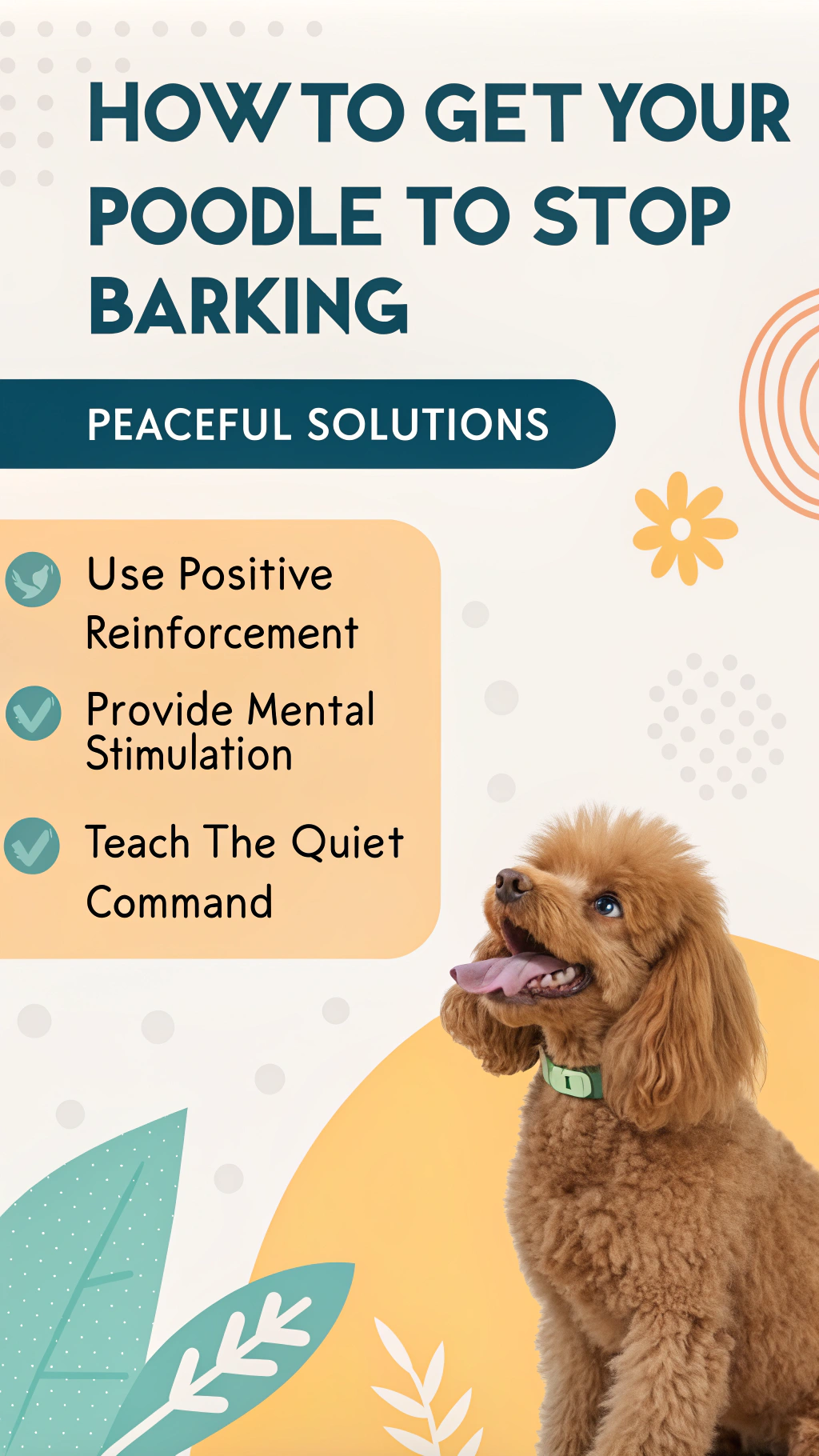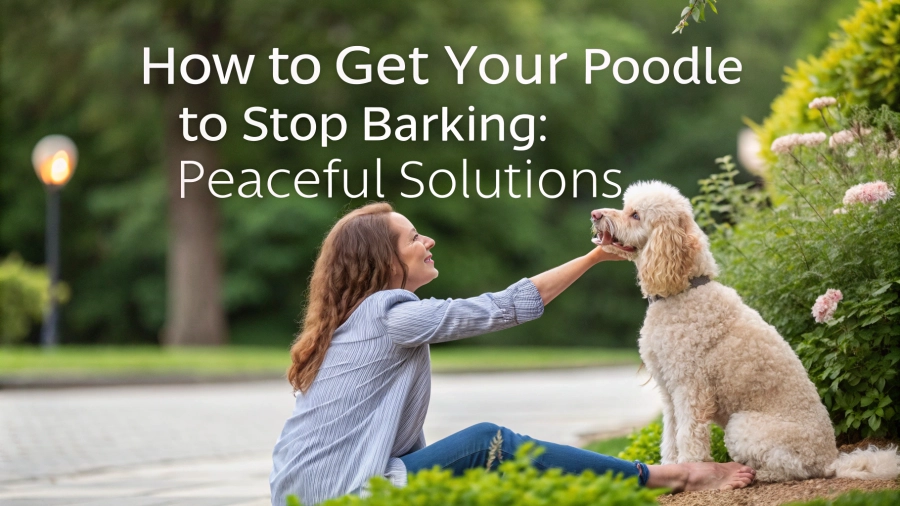Are you struggling with your poodle’s constant barking? It can be frustrating and stressful.
But don’t worry, there are peaceful solutions. Poodles are intelligent and active dogs. They often bark to communicate or express their feelings. This behavior can disturb your peace and your neighbors. Finding the right way to calm your poodle is essential.
In this guide, we will explore gentle methods to reduce barking. By understanding your poodle’s needs and using positive techniques, you can enjoy a quieter and more harmonious home. Let’s dive into these effective and kind solutions.

Understanding Poodle Barking
Poodles are known for their intelligence and playful nature. But, their barking can sometimes become a problem. To stop your poodle from barking, you must first understand why they bark. This section will help you identify the reasons and patterns behind your poodle’s barking behavior.
Common Reasons
There are several reasons why a poodle might bark. Here are some common ones:
- Attention-seeking: Poodles often bark to get your attention.
- Alarm or fear: They may bark at unfamiliar sights and sounds.
- Boredom: A bored poodle might bark to entertain itself.
- Separation anxiety: They can bark when left alone for too long.
- Territorial behavior: Poodles may bark to protect their territory.
Behavioral Patterns
Understanding your poodle’s behavioral patterns can help you address their barking. Here are some patterns to look out for:
- Time of day: Notice if your poodle barks more at certain times.
- Triggers: Identify specific triggers that cause your poodle to bark.
- Body language: Pay attention to their body language when barking.
- Frequency: Observe how often your poodle barks in a day.
Recognizing these patterns will help you create a strategy to reduce your poodle’s barking. Consistency is key in addressing this behavior.
Training Basics
If your poodle barks too much, training can help. Let’s look at some basic steps to get your poodle to stop barking. These methods are simple and effective. They can make a big difference.
Consistent Commands
Start with consistent commands. Use the same word or phrase each time. This helps your poodle understand what you want. For example, say “quiet” or “stop” every time they bark. Do not change the command. Consistency is key.
Make sure everyone in the house uses the same command. This avoids confusion. Your poodle will learn faster if everyone is on the same page.
Positive Reinforcement
Another important part of training is positive reinforcement. Reward your poodle when they stop barking. Give them a treat or praise them. This makes them understand that being quiet is good.
Here are some examples of positive reinforcement:
- Give a small treat when they stop barking.
- Use a favorite toy as a reward.
- Praise them with words like “good dog” or “well done”.
Be sure to reward them right away. This helps them link the reward with the action. Over time, they will bark less and less.
Training your poodle takes time and patience. Consistent commands and positive reinforcement are key. Follow these steps to help your poodle become quieter and more peaceful.
Socialization Techniques
Socialization techniques play a crucial role in helping your poodle stop barking excessively. By introducing them to new environments and other dogs, you help them become more comfortable and less reactive. This can lead to a calmer, quieter poodle. Let’s explore these techniques in detail.
Introducing New Environments
Expose your poodle to different places. Take them to parks, busy streets, and quiet neighborhoods. A variety of experiences helps them adjust to new sights, sounds, and smells. Use positive reinforcement. Reward them with treats and praise. This creates a positive association with new environments.
Gradually increase the time spent in these places. Start with short visits. Slowly make them longer as your poodle becomes more comfortable. Keep a close eye on their behavior. If they seem stressed, take a step back and try a quieter environment first.
Meeting Other Dogs
Socializing with other dogs is essential. Arrange playdates with friendly dogs. Begin with one-on-one meetings. This helps your poodle get used to other dogs without feeling overwhelmed.
Use a neutral location for the first meeting. A familiar place can make your poodle territorial. Monitor their interactions. Look for positive signs like wagging tails and relaxed body language. If things go well, gradually introduce more dogs.
Joining a local dog training class can also be beneficial. It provides a structured environment for socialization. Plus, professional trainers can offer valuable tips and support.
Remember to be patient and consistent. Socialization takes time. With the right approach, your poodle will become more comfortable and less likely to bark excessively.

Exercise And Mental Stimulation
Ensuring your poodle gets enough exercise and mental stimulation can significantly reduce excessive barking. A bored or under-exercised poodle tends to bark more. Let’s explore how daily walks and interactive toys can help.
Daily Walks
Daily walks are essential for poodles. They help expend energy and provide mental stimulation. A tired dog is a happy dog.
Here are some tips for effective walks:
- Walk your poodle twice a day.
- Vary the route to keep it interesting.
- Allow sniffing time for mental stimulation.
- Use a harness for better control.
Walking is not just physical exercise. It also engages your poodle’s senses. This reduces boredom and decreases the urge to bark.
Interactive Toys
Interactive toys can keep your poodle occupied. They provide mental challenges and keep your dog busy. This reduces barking.
Consider the following types of interactive toys:
| Toy Type | Benefits |
|---|---|
| Puzzle Toys | Enhances problem-solving skills. |
| Chew Toys | Provides a healthy outlet for chewing. |
| Treat-Dispensing Toys | Rewards your poodle, keeping them engaged. |
Use these toys during times when your poodle is prone to bark. This can be during work hours or when you are busy. Switching toys regularly keeps your poodle interested.
Interactive playtime with you also strengthens your bond. It makes your poodle feel more secure and less likely to bark out of anxiety.
Creating A Calm Environment
A calm environment is crucial for reducing your poodle’s barking. Dogs often react to their surroundings. A peaceful home helps keep your poodle relaxed. This section covers ways to create a calm space for your poodle.
Comfortable Spaces
Create a comfortable space for your poodle. Use a soft bed and favorite toys. Ensure the area is free from loud noises. This helps your dog feel safe and secure.
| Item | Purpose |
|---|---|
| Soft Bed | Provides comfort and relaxation |
| Favorite Toys | Offers distraction and entertainment |
| Quiet Area | Reduces stress from loud noises |
Background Noise
Background noise can mask sounds that trigger barking. Use a white noise machine or play soft music. These sounds help keep your poodle calm.
- White noise machines
- Soft music
- Nature sounds
White noise blocks sudden noises that may startle your dog. Soft music has a soothing effect. Nature sounds mimic a peaceful environment.
Addressing Anxiety
Many poodles bark due to anxiety. Addressing this anxiety can reduce excessive barking. Understanding the root cause is crucial. There are several strategies to help calm your anxious poodle.
Recognizing Triggers
Identifying what causes your poodle to bark is the first step. Common triggers include loud noises, strangers, or separation. Observe your poodle’s behavior closely.
- Do they bark at the doorbell?
- Do they react to other dogs?
- Does their barking increase when alone?
Keep a journal of these triggers. This will help identify patterns. Once you know the triggers, you can address them more effectively.
Calming Strategies
There are several techniques to calm an anxious poodle. These methods can help reduce their barking.
- Exercise: Ensure your poodle gets enough physical activity. A tired dog is less likely to bark.
- Comfort Items: Provide items like a favorite toy or blanket. These can offer comfort when they feel anxious.
- Safe Space: Create a quiet, safe area for your poodle. This can be a crate or a specific room.
- Training: Use positive reinforcement to train your poodle. Reward them when they remain calm.
- Routine: Maintain a consistent daily routine. Predictability can reduce anxiety.
Each dog is unique. Some strategies may work better for your poodle than others. Be patient and persistent. Your poodle will feel more secure over time.
Professional Help
If your poodle’s barking is driving you crazy, you might need professional help. Expert guidance can provide effective solutions and ensure your pet’s well-being. Let’s explore some professional options available for you.
Dog Trainers
Professional dog trainers specialize in behavior modification. They can teach your poodle to bark less. Trainers use positive reinforcement techniques. This means rewarding good behavior instead of punishing bad behavior.
- Trainers can identify triggers for barking.
- They create personalized training plans.
- Sessions can be held at home or in training centers.
Finding a certified trainer is important. Look for trainers with good reviews. Ask for references. Make sure the trainer uses humane methods.
Veterinary Advice
Sometimes, barking is a sign of a medical issue. A vet can check your poodle’s health. They can rule out problems like pain or anxiety.
| Issue | Possible Solution |
|---|---|
| Anxiety | Medication or calming products |
| Pain | Treatment for underlying condition |
If your poodle is healthy, a vet might suggest seeing a behaviorist. Veterinary behaviorists have special training in animal behavior. They can offer advanced solutions for excessive barking.

Patience And Consistency
Training a poodle to stop barking can be challenging. But with patience and consistency, you can achieve a peaceful home. These two elements are crucial for success. Without them, progress will be slow and frustrating.
Daily Practice
Daily practice is essential. Spend at least 15 minutes every day on training. This keeps the lessons fresh in your poodle’s mind. Break the training into short, focused sessions.
- Morning: 5 minutes
- Afternoon: 5 minutes
- Evening: 5 minutes
Repetition helps reinforce the behavior you want. Use positive reinforcement like treats and praise. This makes training enjoyable for your poodle.
Tracking Progress
Keep track of your poodle’s progress. This helps you see what works and what doesn’t. Use a simple table to log each session.
| Date | Time | Duration | Behavior |
|---|---|---|---|
| Oct 1 | Morning | 5 min | Barked less |
| Oct 1 | Afternoon | 5 min | Quiet |
Review your log weekly. Adjust your training based on the results. This makes your efforts more effective.
Frequently Asked Questions
How Can I Stop My Poodle From Barking?
To stop your poodle from barking, use positive reinforcement and consistent training. Provide mental stimulation and physical exercise. Identify and address the cause of the barking.
Why Does My Poodle Bark So Much?
Poodles bark due to boredom, anxiety, or lack of exercise. Identifying the cause helps in addressing the behavior effectively.
Are There Training Methods To Reduce Poodle Barking?
Yes, training methods like positive reinforcement, clicker training, and desensitization can help reduce poodle barking effectively.
Can Exercise Help Reduce My Poodle’s Barking?
Regular exercise can reduce your poodle’s barking by keeping them mentally and physically stimulated, preventing boredom and anxiety.
Conclusion
Quiet your poodle’s barking with patience and consistency. Use positive reinforcement. Practice regular exercise and play. Provide mental stimulation with toys and puzzles. Establish a calm environment. Address underlying anxieties promptly. Consistent training works wonders. Avoid yelling or punishing your dog.
Seek professional help if needed. With dedication, your home will become more peaceful. Enjoy the company of your well-behaved poodle.

